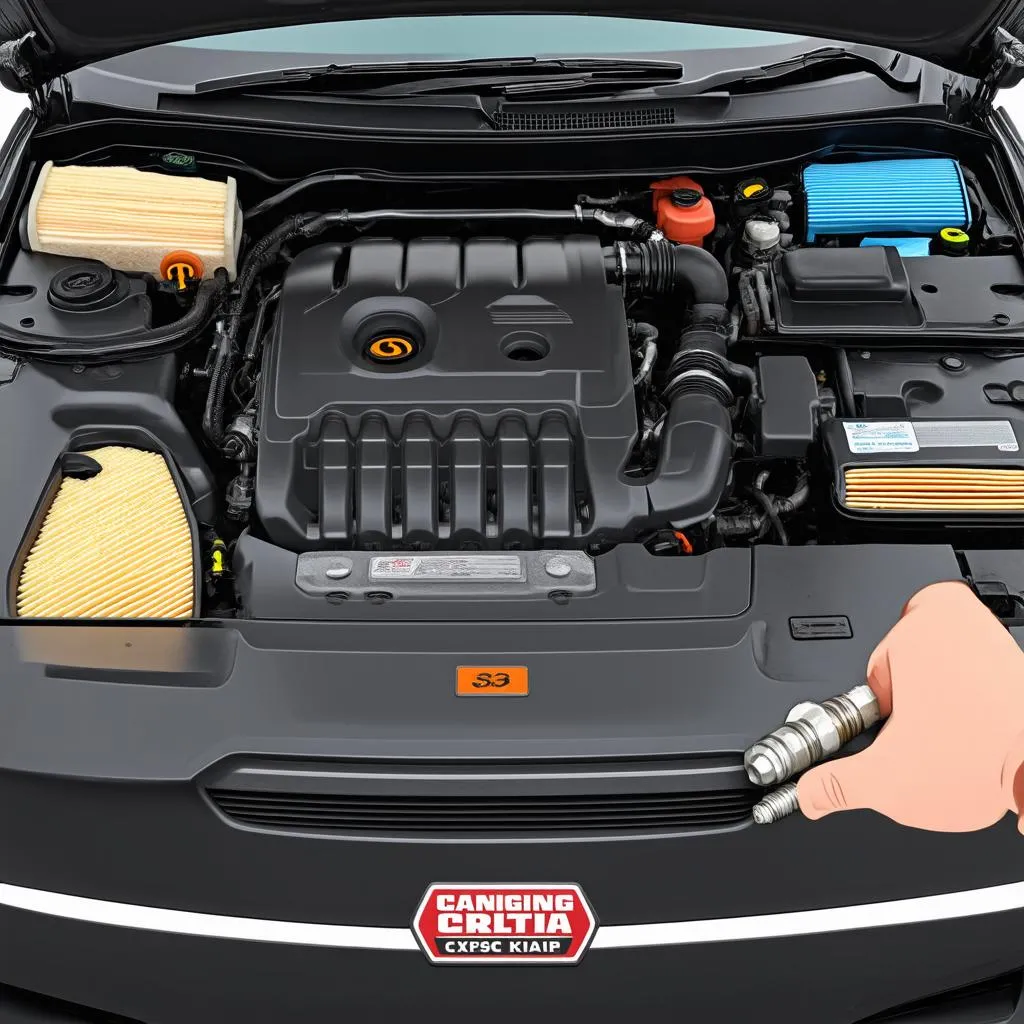Have you ever encountered the dreaded “Check Engine” light illuminating on your dashboard? The feeling can be unsettling, leaving you wondering what’s wrong with your vehicle. And while the Check Engine light itself doesn’t reveal the exact issue, it can sometimes point to a specific problem code. One such code, the infamous “P0300”, can be a real head-scratcher for car owners.
The Meaning of OBD Code P0300
The OBD code P0300 is a universal code that indicates a “random/multiple cylinder misfire detected”. In simpler terms, your car’s engine is misfiring in at least one cylinder, but the exact cylinder causing the issue is unknown.
Imagine this scenario: you’re driving down a busy highway, and suddenly, your engine starts to sputter and cough, making the car feel sluggish. The Check Engine light pops on, and you’re left wondering what just happened. This scenario is a classic example of a misfire, and the OBD code P0300 could be the culprit.
A Misfire from a Mechanic’s Perspective:
“A misfire is like a single beat out of sync in a symphony,” explains Mark Johnson, a renowned automotive technician with over 20 years of experience. “It disrupts the smooth flow of power and can lead to engine damage if left unaddressed.”
The Impact of a Misfire on Your Car’s Performance:
- Decreased Engine Power: A misfire can cause your engine to lose power, making it harder to accelerate or maintain speed.
- Reduced Fuel Efficiency: A misfire can lead to increased fuel consumption, as your engine isn’t running efficiently.
- Emissions Problems: Misfires can cause your car to emit more pollutants, potentially impacting the environment.
- Engine Damage: If left unresolved, misfires can lead to significant engine damage, requiring costly repairs.
Causes of OBD Code P0300
The “P0300” code is a general indicator of a misfire, and its root cause can vary greatly. Some common reasons for this code include:
Ignition System:
- Faulty Spark Plugs: Worn-out or damaged spark plugs can prevent proper ignition, causing misfires.
- Spark Plug Wires: Cracked, frayed, or corroded spark plug wires can disrupt the electrical signal to the spark plugs.
- Ignition Coil: A failing ignition coil can’t deliver enough voltage to the spark plugs to ignite the fuel.
Fuel System:
- Faulty Fuel Injectors: A clogged or malfunctioning fuel injector can prevent the right amount of fuel from reaching the combustion chamber.
- Low Fuel Pressure: Insufficient fuel pressure can hinder the combustion process, leading to misfires.
Other Causes:
- Vacuum Leaks: A leak in the engine’s vacuum system can disrupt the air-fuel mixture, resulting in misfires.
- Compression Problems: Low compression in one or more cylinders can contribute to misfires.
- Engine Sensors: Faulty sensors, such as the oxygen sensor or mass air flow sensor, can disrupt the engine’s control system.
Troubleshooting and Diagnosing P0300
“The key to diagnosing P0300 lies in using the right tools and understanding the symptoms,” explains Dr. Daniel Thompson, a leading automotive engineer and author of “The Complete Guide to Engine Diagnostics”.
Tools You’ll Need:
- OBD2 Scanner: An OBD2 scanner is a must-have for reading and clearing diagnostic codes.
- Multimeter: A multimeter is used to check electrical components such as spark plugs, wires, and ignition coils.
- Compression Tester: This device is used to measure the compression in each cylinder.
Diagnosis Steps:
- Read the Diagnostic Codes: Use an OBD2 scanner to read the specific codes stored in the engine control module (ECM).
- Inspect the Spark Plugs: Check the spark plugs for wear, damage, or signs of carbon buildup.
- Test the Spark Plug Wires: Inspect the spark plug wires for cracks, fraying, or corrosion. You can also use a multimeter to check for continuity.
- Inspect the Ignition Coils: Visual inspection for cracks or damage. You can also use a multimeter to check for proper resistance.
- Check Fuel Injector Operation: Inspect fuel injectors for leaks or signs of clogging.
- Check Fuel Pressure: Use a fuel pressure gauge to measure the fuel pressure in the system.
- Inspect for Vacuum Leaks: Check for leaks in the vacuum hoses and lines using a vacuum gauge or smoke machine.
- Perform a Compression Test: A compression test can reveal problems with cylinder compression.
 Spark Plug Inspection
Spark Plug Inspection
Solutions for P0300 Code
Once you’ve identified the root cause of the P0300 code, you can proceed with the appropriate repair.
Common Solutions:
- Replace Spark Plugs: If the spark plugs are worn or damaged, replacing them with new ones is usually the solution.
- Repair or Replace Spark Plug Wires: Damaged spark plug wires need to be repaired or replaced.
- Replace Ignition Coils: Faulty ignition coils should be replaced.
- Clean or Replace Fuel Injectors: Clogged fuel injectors can be cleaned using a fuel injector cleaner or replaced.
- Repair Vacuum Leaks: Vacuum leaks need to be repaired by replacing damaged hoses or sealing leaks.
- Address Compression Issues: Low cylinder compression often requires a rebuild or replacement of the engine.
 OBD2 Scanner
OBD2 Scanner
FAQs About P0300 Code
“How do I fix P0300 code?”
As mentioned earlier, the repair depends on the cause. You need to diagnose the problem first, which often requires a trip to a mechanic.
“Does P0300 code mean a blown head gasket?”
While a blown head gasket can cause a misfire, it’s not always the culprit for P0300. Other issues, such as faulty spark plugs or fuel injectors, are more common causes.
“Can P0300 code be a sensor issue?”
Yes, a faulty sensor, such as the oxygen sensor or mass air flow sensor, can contribute to a misfire and trigger the P0300 code.
“Can I clear P0300 code myself?”
You can use an OBD2 scanner to clear the code, but it won’t fix the underlying problem. The code will likely reappear until the issue is addressed.
Preventing Future Misfires
“Maintaining your car’s engine is crucial for preventing misfires,” says Dr. Thompson. “Regularly scheduled maintenance, including spark plug replacement and fuel injector cleaning, can go a long way in avoiding these issues.”
Tips for Preventing Misfires:
- Use High-Quality Fuel: Using high-quality fuel helps ensure proper combustion and minimizes the risk of fuel injector clogging.
- Follow the Recommended Maintenance Schedule: Stick to the manufacturer’s recommended maintenance schedule for spark plug replacement, air filter changes, and other vital checks.
- Be Proactive with Repairs: Address any engine issues, like a rough idle or unusual noises, promptly.
 Engine Maintenance
Engine Maintenance
Related Articles:
- OBD Code P0300: Common Causes and Solutions
- Causes of OBD Code P0300 Trailblazer 4.2L
- Chevy Silverado OBD Code P0300
- 2004 Nissan Xterra P0300 OBD Codes
- Cause of OBD Code P0300
Need Help with Diagnostics Tools?
Contact us on WhatsApp: +84767531508 for expert assistance with installing and using diagnostic tools for your European cars. We have experienced automotive technicians available 24/7 to help you.
Don’t let a misfire disrupt your driving experience. Take action to understand the P0300 code and get your car running smoothly again.
Leave a comment below with any questions you have about the P0300 code or share your experience with misfires. We’re here to help!